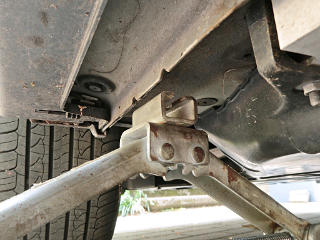
On the way up, once the wheel is mostly unweighted but still in contact with the ground, the lugnuts get loosened a little. Then, up she goes.
| I was more motivated to inspect the rear brakes due to their light scraping I kept hearing when starting a drive, and then with a lot of family stuff demanding my attention through 2022 I never got around to the fronts until a year later. So at this point I'd had the car almost two years, and it was high time. The spring "slosh-out" to try and rid the undercarriage of the winter salt had already happened, the plastic belly-covers were back on, the gear-reduction fluid had already been changed for the second time, and this was about all that was outstanding to take care of for the year. |
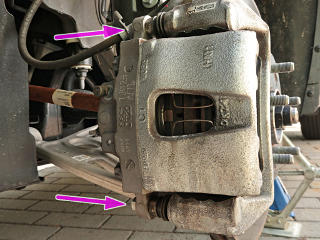
|
These are the two caliper bolts we want: 14 mm. A box wrench works quite well for this. |
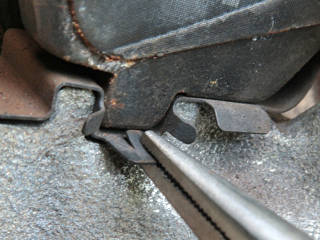
|
Squeezing the tab downward while pulling on the pad seems to work best, without permanently bending the tab out of place. It's springy metal, so it can handle this. |
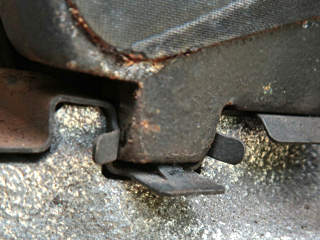
|
Once you've got the barb ducked under, you're golden! Getting this done on the inner-side pads involves a little contortion into the wheel well to see it. |
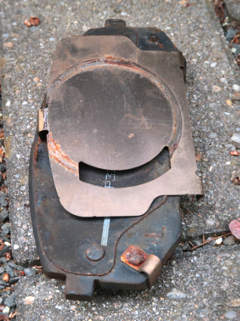
|
This is interesting: the hollow caliper piston bears on this shim against the
inner pad, and there's this this slot cut into it which, from the obvious
wear pattern, is along the line of the piston edge itself.
Shims are part of the many design aspects of disc brakes to prevent squeal
and chatter, but this one takes it to another level.
Given the orientation of the slot, the piston will exert a little less
pressure on the "leading", or upper end of the pad during normal forward
wheel rotation.
There is obscure wisdom found here and there, often in the bicycle world,
that the trailing edges of most types of brakes should make contact with the
rotating parts first and/or most firmly, which tends to prevent oscillation
starting.
I couldn't find any good articles specifically about this, but I did come across one relevant line in a preview of a massive e-book entitled "Braking of Road Vehicles":
"Disc brake squeal can often be eliminated by moving the contact between
the piston and the pad backplate towards the trailing end, e.g. by a shim."
The book is evidently an extensive treatise on the science and engineering
of brake systems, likely required reading for anyone designing them, and
priced in an accordingly sky-high way typical of textbooks.
There could be no other reason this slot is here, in contrast to every other
pad shim I've seen which is solid all the way across.
|
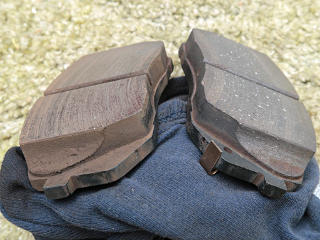
|
Plenty of "meat" left on these pads, of course, at around 25,000 miles. The benefits of regenerative braking! The one on the right has been cleaned off; the left one is as it came out. |
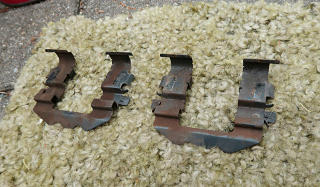
|
The pad clips should also come off for cleanup. Top and bottom are identical. |
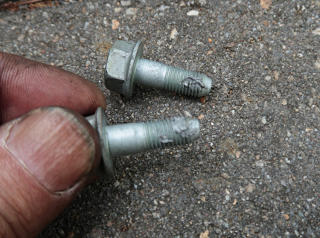
|
The caliper bolts came out dead-dry, so it's time for a little anti-seize. These will be removed semi-regularly on the inspection/cleaning schedule, so we don't want the threads binding up over time. |
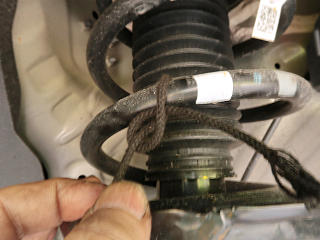
|
Let's not forget to recover our tie-up string... |
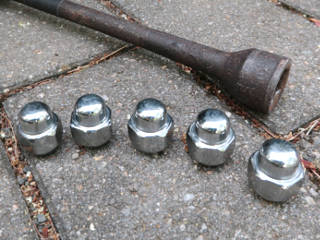
|
Shine up your nuts!
[That cross-wrench is older than I am; from my late dad's workshop. Still perfectly serviceable, though, as are many of his other tools.] |